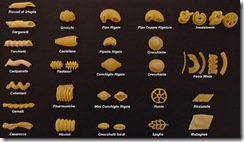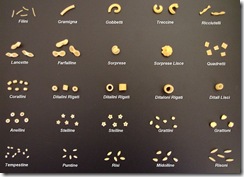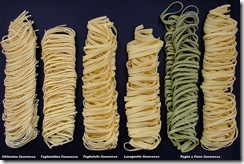L’Etimologia della Pasta Posted by Serena on May 9, 2011 in Italian Language
I thought it would be fun to have a look at just a few of the innumerable varieties of pasta that we produce in Italy, and to discover where they get their names from. Click on the images below to enlarge them.
Va bene, cominciamo con la pasta italiana più famosa: gli spaghetti (o.k. let’s begin with the most famous Italian pasta: spaghetti)
The name spaghetti comes from the word spago = string, and means ‘little strings’, we even have spaghettini, literally ‘very little strings’
Even thinner than spaghetti are i capellini, from the word capelli = hairs + the suffix ‘ini’ = ‘little hairs’. The full name of this pasta is capellini d’angelo – ‘little hairs of an angel’
Fat spaghetti, or spaghettoni, are called vermicelli from the word vermi = worms. It’s probably best not to think about the name whilst eating them!
The fat spaghetti with a hole through the middle are called bucatini, from the word bucato = holed + the suffix ‘ini’ = little holed
Let’s move on to the next group:
Penne take their name from quills, the feathers which were once dipped in ink and used for writing. The English word ‘pen’ shares the same root
Rigatoni means ‘big lined or striped’ and comes from the word rigato = lined + the suffix ‘oni’ = big
You’ll notice that we also have penne rigate i.e. lined pens, and penne lisce = smooth pens
Fusilli take their name from fuso, the spindle used by spinners. In fact fusilli were originally produced by twisting them around a fuso to give them their spiral form
Farfalle means butterflies, and if you have a look at them it’s easy to see why! You’ll also notice the similarly shaped fiocchi rigati, literally ‘lined bows’
The third group:
In this group we have: riccioli = curls, torchietti – which resemble the screw of a torchio (winepress), and gemelli = twins, which are composed of two pieces of pasta joined together in a spiral
Then there are radiatori = radiators, fisarmoniche = accordions, pipe = pipes, conchiglie = sea shells, orecchiette = little ears, ruote = wheels, and spighe = ears of corn
Group four:
This group contains all the smallest pasta which we use when making la minestra (soup). This type of pasta is called pastina da minestra. Here you will find: filini = little wires, lancette = little spears, anellini = little rings, stelline = little stars, and ditalini which comes from the word ditale = thimble, which is itself derived from dito = finger
Group five:
Tagliatelle comes from the verb tagliare = to cut or slice, hence the name literally means ‘little slices’. Here we also have tagliatelle paglia e fieno = little slices of straw and hay
The etymology of the word lasagne is obscure, and there is a lot of controversy about its origins
There are, of course, many more types of pasta to explore, but perhaps knowing that the next time you eat in an Italian restaurant you may be offered ‘little pieces of string’, ‘butterflies’, ‘sea shell’, or ‘little worms’ will add a special ‘divertimento’ to your meal.
Buon appetito!

Build vocabulary, practice pronunciation, and more with Transparent Language Online. Available anytime, anywhere, on any device.









Comments:
martin deehan:
Grazie mille per questa informazione.
Joanna:
I’m hungry now. 🙂
Jeannet:
Wow! and what about the taste? all the same? Thank you for showing the additional pictures.
Saluti,
Jeannet
Vince:
This is such a delicious learning experience. Who would think we could learn the words for ‘worms’ and ‘angel hair’ in a pasta lesson?
Can you do the same thing for cheeses?
Vince
Valerie:
I like where Vince is going with this!
Pecorino – from Pecora (sheep)!
Bocconcini – from bocca (mouth) – little bites of mozzarella.
Burrata – from ‘buttered’.
It would be the cheese to the maccheroni of this lesson. (Obviously I’ve eaten too much cheese or drunk too much caffe’ – or both).
Serena:
@Valerie Salve Valerie, salve Vince!
A blog on the etymology of Italian cheese is not as easy as the one about the pasta and requires a bit of research, but I’ll try my best. I’m going on holiday for a couple of weeks, perciò penso che dovrete aspettare un pochettino per questo blog.
A presto
Serena
Andreas:
Salve Serena!
Come mi piace la pasta! Davvero, sarebbe interessante sapere se il gusto è silmile o differente. E’ anche divertente sapere ciò che si mangia.
Andreas
Cyril:
The way learned it at school (I am a translator) was Lasagna came from lagana and has been used the longest of all pastas…. somthing like 1800yrs ago.
One theory says it came from the greek word Lagana while
another claims that it was the greek word lasana which in latin was lasanum.
While pasta is a more recent word that has also roots in greek language and I believe was used only in the past 200-300 years.
I do remember that tomatoes arent indigenous to europe and that they only arrived there about 500years ago but Im not 100% sure.